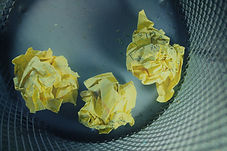Why is air travel considered one of the safest activities you can engage in?
Because pilots don’t have their own way of operating. Before every flight, even commercial pilots with 20 years of experience, rely heavily on checklists. They perform pre-flight tests of the same items in the exact same sequence every time. It’s their standard work.
Why is air travel considered one of the safest activities you can engage in?
Because pilots don’t have their own way of operating. Before every flight, even commercial pilots with 20 years of experience, rely heavily on checklists. They perform pre-flight tests of the same items in the exact same sequence every time. It’s their standard work.

Metrics-Based Process Mapping
A cross-functional process map with time and quality metrics enables us to actually see which step(s) in the process contain waste and need to be improved.

Are your business processes well-defined, efficient, and effective? Are you struggling to improve your department's performance? Are you looking for something beyond traditional swimlane flowcharts that enables you to measure and improve performance?
Metrics-Based Process Mapping is a tactical-level mapping approach that enables improvement teams to make effective, data-based decisions about designing processes and measuring process performance.
The mapping technique integrates the functional orientation of swimlane process maps with key time and quality metrics, which provide teams with an unequivocal way to identify waste and design better workflows. The summary metrics define the degree of improvement that can be expected.
How Does It Benefit The Organization

Identify process waste

Make work easier and safer to do
Quantify the degree of improvement you can expect to achieve

Monitor ongoing process performance


Train & onboard new hires with clear expectations on quality

Design a new process from scratch
How We Can Help
We facilitate workshops and coach business teams in using Metrics-Based Process Maps so they learn how to do it by themselves during Kaizen events.
Metrics-Based Process Mapping relies on three key performance metrics. Two are time-based metrics and one is a quality metric.

Time-Based Metrics
Process Time (PT) = Is the hands-on time it takes to perform the task
Lead Time (LT) = Is the PT + any waiting or delays in doing the work
Quality-Based Metrics
% Complete & Accurate (%C&A) = Is the % of time that output generated by one person or team doesn’t require rework by the immediately next receiving party, nor anyone downstream from the immediately next receiving party.

Rework is defined as:
-
Correcting errors, i.e. correcting information that’s wrong
-
Adding missing information that should have been supplied
-
Clarifying vague information that could have been clear to begin with
It's difficult to solve problems or make improvements of any sort without a deep understanding of the problem or what you seek to improve.
In cross-functional work processes, where work passes back and forth between departments, it can be exceedingly difficult to gain the degree of understanding that’s needed by merely observing the work and talking with the people who do the work.
Visualizing the work on paper and with metrics, layers in a whole other layer of understanding. While flowcharts are good to show how work should flow, they are inadequate in pinpointing where the improvements should occur and why. Measuring processes provides deeper insights, which results in better and longer-lasting improvements.
